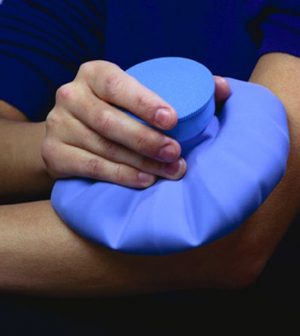- Navigating Your Midlife Crisis: Embracing New Possibilities
- City Raccoons Showing Signs of Domestication
- Mapping the Exposome: Science Broadens Focus to Environmental Disease Triggers
- One Week Less on Social Media Linked to Better Mental Health
- Your Brain Changes in Stages as You Age, Study Finds
- Some Suicide Victims Show No Typical Warning Signs, Study Finds
- ByHeart Formula Faces Lawsuits After Babies Sickened With Botulism
- Switch to Vegan Diet Could Cut Your Greenhouse Gas Emissions in Half
- Regular Bedtime Does Wonders for Blood Pressure
- Dining Alone Could Mean Worse Nutrition for Seniors
Pain Relief: When to Use Cold, When to Use Heat

Sore from a workout? You don’t have to reach for pain relief medicine when ice or heat will help. But when should you go cold and when should you go warm?
Ice is the go-to therapy when an injury first happens. It can stop the swelling of a sprained ankle, for instance, and numb the pain. The traditional approach is 20 minutes on, 20 minutes off at first. You might step this down to 20 minutes every two or three hours on the second and third days. If you have a long-term injury, icing the area for 10 to 20 minutes after a workout can be soothing.
Ice options include a plastic bag of crushed ice, a reusable ice pack or even a bag of peas that can be refrozen for use again — label it so no one eats them. Whatever you use, always place a thin towel between the ice and your skin to prevent skin damage.
Once the swelling of an injury is gone, you can switch to heat. Heat eases discomfort and promotes healing. With a chronic condition like arthritis, it can soothe achy joints and lessen your pain. You can follow the same type of schedule you would when icing.
Just as you don’t want to freeze your skin with ice, you don’t want to burn it with heat. So watch the settings on a heating pad. You want warmth, but you don’t want it to feel hot. Another choice is a reusable heat pack that you warm in the microwave. You can find versions that come shaped for the body part needing treatment. Even just a warm shower or bath can help. The water should be between the high 90s and 100 degrees.
Although these are considered safe at-home remedies, talk to your doctor first if your injury could be serious — for instance, you notice a lot of swelling and pain — or if you have any chronic health conditions, including any that prevent you from feeling hot and cold, like neuropathy, often from diabetes.
More information
The American Academy of Pediatrics has more on treating injuries with ice and heat.
Source: HealthDay
Copyright © 2025 HealthDay. All rights reserved.










